| Lithines is situated 25 km
south of Sitia.
On one side the
village is bounded by the road Sitia-Ierapetra and on the other side by the slope down towards the valley,
separating the village from the neighbouring villages of Azali and Pefki.
|
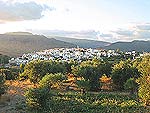
|
| The village was mentioned for
the first time in 1369, but it is thought to be founded as early as 1082,
where emperor Alexios Komninos I. -
according to a document from the Gonia monastery on the Rodopos peninsula
- is supposed to have sent 12 families to Crete in order to consolidate
the Byzantine Empire's power over the island.
|
| There are, however, some doubts
about the authenticity of the document, as it might be about native
families that during this period of time were allocated large amounts of
land in the area. The 12 families were: Fokas, Skordilis, Gavalas,
Kalafatos, Arkoleos, Chortatzis, Mousouros, Varouchas, Melissinos, Litinos,
Argyropoulos and Vlastos.
|
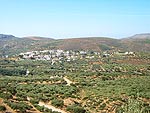
|
| Lithines lies in a region
favoured with many springs,
providing
the area with ample amounths of water, and the area har therefore most
likely been inhabited since antiquity, which also the discovery of vaulted
tombs and buildings from the first geometric period (1100-800 B.B.)
suggest.
|
| The village consists mostly of
narrow streets where the houses cluster at various levels. One of the
characteristics of the village is the well kept houses with the many
outdoor staircases, and you often get the impression of being on an
Cycladic island rather than in a Cretan village.
|
|
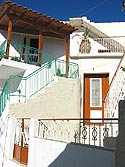
|
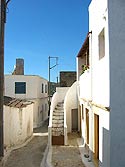
|
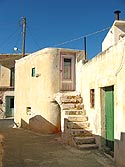
|
|
|
|
|
|
| Another characteristic
is the many churches in the area. The best known is the old Panagia church
from the 15th century. In the church is among others things an old Panagia
icon, which according to tradition performs miracles. It is also said that
if meat is carried across the church square, it will rot immediately. It
happened in this way many years ago, that a Turk intended to provoke the
Christian inhabitants of the village by carrying some meat past the church,
while taunting Panagia. Immediately the meat rotted - and that was not all
of it, because when he the following day went out to his flock, all the
sheep had died too.
|
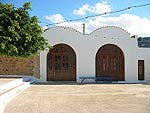
|
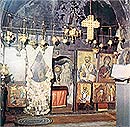 |
Except for the services,
baptism is the only religious ceremony that takes place, as neither
weddings and much less funerals are allowed in this church. As a matter of
fact it is not even allowed to enter the church the same day that you have
been to a funeral - this also applies to the priest. |
|
|
|
|
|
| At the end of the Venetian
period, the Vlachos family owned the village, and behind the old school in
the Agios Athanasios church is an inscription that says:
|
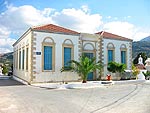
|
| ... This divine and
glorious church to our holy father Athanasios, archbishop over Alexandria,
is renovated through contributions, work and expenses by the princely
squire Georgios Vlachos … 1587. |
|
The old school |
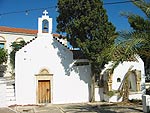 |
Outside the church is the
burial plot of the Vlachos family, and in the wall is a row of built-in
plates that the builders
reputedly ate off. |
|
|
|
|
|
|
In the Turkish period there
was a fortress of three storeys in the village. In 1828 the Turks of the
area came to it, as a rebellion had broken out north of the village. 140
armed men and 250 women barricaded themselves in the fortress, which the
Cretan resistance leader, Tsouderos, after two days of siege tried to blow
up. He did not succeed, but the wooden floors caught fire which panicked
the trapped people. The saw a big barrel with something they thought was
water in it, and they poured it on the fire. To their disadvantage it
proved to be raki, so in a few seconds the whole building was enveloped in
flames, and they all died, except for one woman who managed to jump out of
the building.
|
| The fortress was completely
destroyed in this disaster, so there are no remains of it today.
|
|
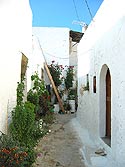
|
 |
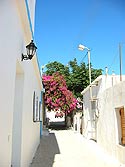 |
|
|
|
|
|
| A few kilometres northwest of
Lithines is the Agios Antonios cave, named after the small chapel at the
entrance. |
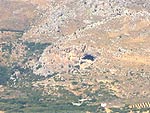
|
|
|
|
|
|
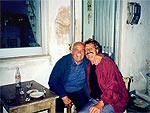
|
In the summer of 1984, I stayed
in Lithines for a longer period of time and I spent several
hours in the company of Kostas Konstantakis at his café. He told me many
of the myths connected to the area. One of them, for example, says that
the cave was supposed to contain a tremendous treasure. Consequently, a
Turk once climbed up into it to find the treasure but without any result.
Hardly had the Turk climbed down by a liana from the high situated cave
when he realized that he had forgotten his knife inside. Even though he
knew that a visit to the cave was allowed only one time, he still wanted
to get his knife back, so he climbed up the liana again. Just before he
reached the cave, the liana changed into a snake that bit the Turk, and he
fell dead to the ground.
|
| The next day I went up the cave
to se with my own two eyes the place, that Kostas so vividly and
convincingly had described. I did not succeed in entering the cave, but
the little Agios Antonios chapel was beautiful, and there was a
magnificent view down over the valley. When I visited Kostas again in the
evening, I told him that I had gone to the cave and had found a knife in
it. I showed him my Danish pocket knife which must have looked very
strange to him, for his eyes became big and wondering, and he stammered
out: "But, but, this must be the Turk's knife; then his story must be
true!" I now made confession, and when Kostas realized the connection,
his eyes flashed - but in a second they sparkled, and he burst into a
heartfelt laughter.
|
|

|
|
| Unfortunately Kostas is no
longer alive, but I remember his stories about old times and our daily
banters with great delight.
|
|
|
|
|














